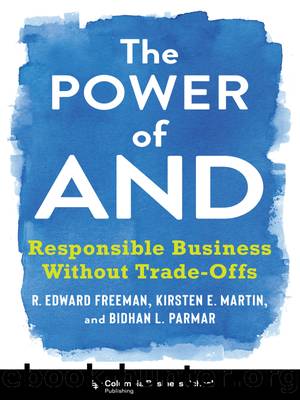The Power of And by R. Edward Freeman

Author:R. Edward Freeman
Language: eng
Format: epub
Tags: BUS008000, Business & Economics/Business Ethics, BUS094000, Business & Economics/Green Business
Publisher: Columbia University Press
Published: 2020-06-02T00:00:00+00:00
Business Is Embedded in the Physical World: Societal Issues, Partnerships, and Institutional Failure Again
The impact of pollution on the environment and its role in climate change comes into sharper focus with each passing year. And business has navigated its role in the physical world in an evolving manner. Business has followed a typical cycle of responses to the environmental movement: manipulation, denial, avoidance, compromise, acquiescence, and then going beyond compliance.50 In the early environmental movement, business saw scientific studies and environmental NGOs as fringe groups without much legitimacy. For example, in the early 1970s, chemical companies showed little concern with the growing evidence of the dangers of CFCs.51 Steel companies had to be sued before they complied with the Environmental Protection Agency (EPA), as many businesses considered the agency to be illegitimate.52 This initial disregard for environmental concerns mirrored the U.S. tobacco industry’s tactics to evade regulation by the FDA.53
Today we see a range of ways business is embedded in the physical world that parallel the examples above. First, we have examples of businesses that are working to live in a mutually beneficial relationship with their community, who have aimed to refrain from polluting or harming the environment. McDonald’s attempts to source their food products in such a way that minimizes the impact on ecosystems and biodiversity; the company also focuses on farming viability and economic stability.54 Additionally, McDonald’s aims to have 100 percent of its packaging sourced from recycled or certified sources by 2020. McDonald’s also minimizes the life cycle impact of food and packaging by reducing food and packaging waste, thus protecting resources and conserving forests. We also see more sustainable solutions from firms across industries. Nike has focused on shrinking its environmental footprint by introducing ColorDry, and it dyes shirts with recycled CO2 rather than water.55 Similarly, Target is developing an eco-clothing line and has focused on responsible sourcing by working with vendors to make them more transparent.56
Second, businesses partner with nonprofit organizations to focus on environmental impact. For example, the apparel industry is a major consumer of electricity and contributor to greenhouse gas emissions.57 To achieve its goal of using 100 percent renewable energy by 2025, Nike collaborated with MIT Climate CoLab to hold a competition called Materials Matter to quantify the environmental impact of different material choices for garments. In the competition, one team created an app where designers can estimate the impact of their material choices on the climate, fitting into a movement of sustainable clothing. And Patagonia was a founding member of the Textile Exchange, in partnership with other like-minded companies, in a move to better understand the social and environmental benefits of environmentally conscious textiles.
The food industry has seen companies partnering up on environmental issues as well. For example, McDonald’s, which initially created a lot of packaging and solid waste, has partnered with the Environmental Defense Fund to focus on waste reduction and minimization of its environmental footprint. The result was a reduction in materials used, a greater commitment to recycling, and increased composting.
Download
This site does not store any files on its server. We only index and link to content provided by other sites. Please contact the content providers to delete copyright contents if any and email us, we'll remove relevant links or contents immediately.
| Ethics | Etiquette |
| Fashion & Image | Health & Stress |
| Motivation & Self-Improvement | Work Life Balance |
| Workplace Culture |
Tools of Titans by Timothy Ferriss(6950)
Change Your Questions, Change Your Life by Marilee Adams(6641)
Deep Work by Cal Newport(5471)
Man-made Catastrophes and Risk Information Concealment by Dmitry Chernov & Didier Sornette(4738)
Big Magic: Creative Living Beyond Fear by Elizabeth Gilbert(4723)
The Slight Edge by Jeff Olson(4722)
Digital Minimalism by Cal Newport;(4545)
The Motivation Myth by Jeff Haden(4528)
Stone's Rules by Roger Stone(4417)
Ego Is the Enemy by Ryan Holiday(3991)
The Laws of Human Nature by Robert Greene(3946)
Tuesdays with Morrie by Mitch Albom(3832)
Rising Strong by Brene Brown(3783)
Eat That Frog! by Brian Tracy(3514)
Skin in the Game by Nassim Nicholas Taleb(3462)
The Money Culture by Michael Lewis(3284)
Skin in the Game: Hidden Asymmetries in Daily Life by Nassim Nicholas Taleb(3264)
Believe It to Achieve It by Brian Tracy & Christina Stein(3206)
Bullshit Jobs by David Graeber(3180)
